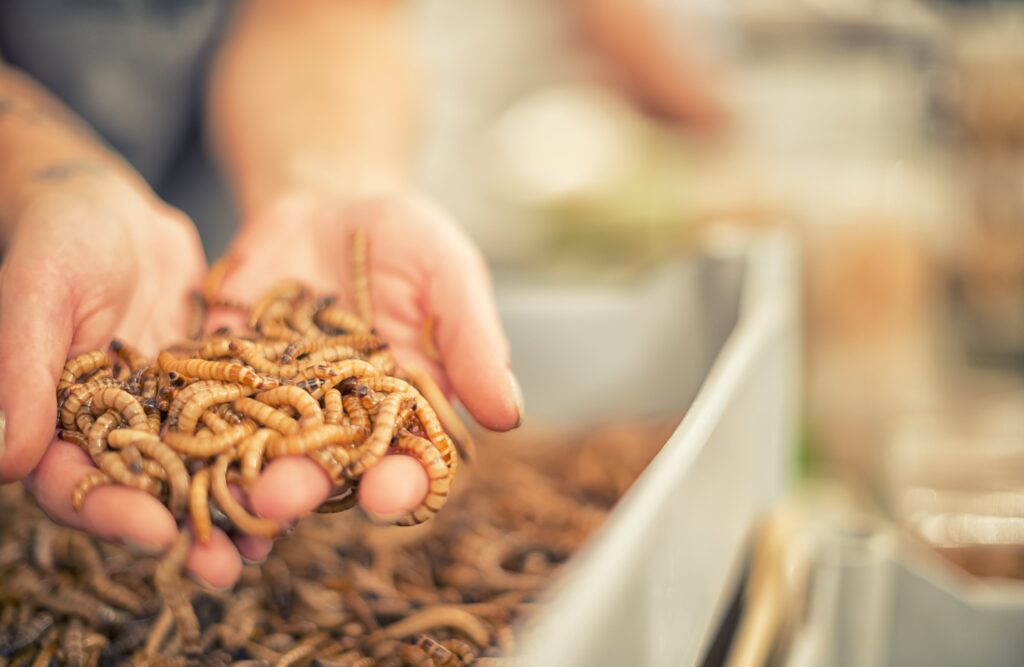Authors
Click here to listen to the accompanying podcast.
Competition for land, particularly on an island, is hardly a novel challenge in the UK. Agricultural intensification as well as non-food drivers, including infrastructure projects and expanding urban areas, have all increased pressure on land use. In this article we will look at the various demands on our land and consider the role which insect protein could play in alleviating this pressure.
Demands
The continued demand for housing and energy, as well as food production all have a substantial impact on land use. These demands must be balanced with the space needed for nature to provide the ecosystem services that are central to our existence and prosperity.
There is considerable pressure on the agriculture sector to farm sustainably, including recognising the finite supply of land. The use of insect protein in animal feed (in particular) is seen as one of the ways in which the agriculture sector can address this issue.
Land used for feeding livestock
It is estimated that 40% of the UK’s arable land area (around 2 million hectares) is used for growing crops to feed to livestock.[1] The UK also imports more than 3million tonnes of soya each year,[2] which equates to 850,000 hectares of land use outside of the UK.[3] Around 90% of imported soya is used in feed for livestock.[4] The majority of imported soya comes from South America and so this is considered a major contributor to deforestation.
There is huge potential for a significant proportion of crops grown for livestock feed to be replaced by insect protein. This would free up land both in the UK and globally, easing the competition for land. The 2021 WWF Report: ‘The Future of Feed: A WWF Roadmap to Accelerating Insect Protein in UK Feeds’ projected that “…the total demand for insect meal from the UK’s pig, poultry and salmon sectors could reach the region of 540,000 tonnes a year by 2050. Of this, around 240,000 tonnes of insect meal per year could be sourced from UK insect farms.”
Transition to a circular economy
As well as freeing up land, the use of insects in our food system has huge potential for helping the transition towards a circular economy. In particular, their ability to convert organic matter into high quality protein. Insects are extremely efficient converters of waste to protein. As a direct comparison, to produce 1kg of cricket protein requires 1.7kg of feed, to produce the same amount of beef protein requires 10kg of feed. As well as high feed conversion rates, insect production has the advantage of a low environmental footprint, requiring substantially less land and water for production. This is a role that insects perform so effectively that there is, simply, no such thing as waste in nature.
Nutritional value of insects
The nutritional profile of insects is also persuasive when considering their role in the food chain. In some instances, insect protein is capable of replacing soymeal and fishmeal in animal feed with a comparative essential amino acid protein profile.
Insect protein production
The development of the insect protein industry in the UK in particular has demonstrated how versatile and adaptable the sector can be at providing on-farm solutions not only for surplus crops (over 3 million tonnes of food waste per year is created on farms in the UK[5]) and by-products (e.g. brewers grain or ground coffee) but also as a means of utilising excess energy, for example, generated from an anaerobic digester. We are already seeing mobile insect production units being deployed on farms to feed crop/food surplus to soldier-fly larvae, which is high in protein and other essential nutrients and then used to feed to laying hens.[6]
In addition, frass, which is the mix of excreta, feeding substrate and other matter left once farmed insects are ‘harvested’, is a valuable co-product as a fertiliser. Further demonstrating the circular properties of this industry. The value of frass is now considered to be on- par with insect protein itself.
Legislation lagging behind
Despite the prospects presented by the industry, on a number of fronts, developments in the legislation required to support the industry in the UK have failed to keep pace. Whilst EU legislation has forged forward to recognise the role that insects have in the feed system for pigs and poultry (acknowledging that insects form a natural part of the diet for both of these animals), in the UK the feeding of insect protein to chicken and pigs remains prohibited (except as live larvae in chicken feed). There are also considerable regulatory restrictions on the use of food surplus as feed for insects.
The insect protein industry in the UK demonstrates huge potential for tackling some of the most pressing issues that the agriculture sector faces. It also presents great opportunities for farmers looking for alternative ways to diversify their businesses.
However, in order to realise the potential of insects in reducing the use of land for production of animal feed and to stop the loss of vital nutrients through food waste, the legislation must now reflect the substantial developments in the industry.
[1] WWF ‘The future of feed: How low opportunity cost livestock feed could support a more regenerative UK food system’ report (July 2022)
[2] Resilience of the UK food system regarding demand for soy (foodsystemresilienceuk.org)
[3] WWF ‘The future of feed: How low opportunity cost livestock feed could support a more regenerative UK food system’ report (July 2022)
[4] Resilience of the UK food system regarding demand for soy (foodsystemresilienceuk.org) SEI York, D Chris West and Global Food Security-Food System Research.
[5] WWF ‘Hidden Waste: The scale and impact of food waste in primary production’ report (October 2022)
[6] Current legislation restricts the use of Processed Animal Protein to poultry. Therefore the larvae must be fed live.


